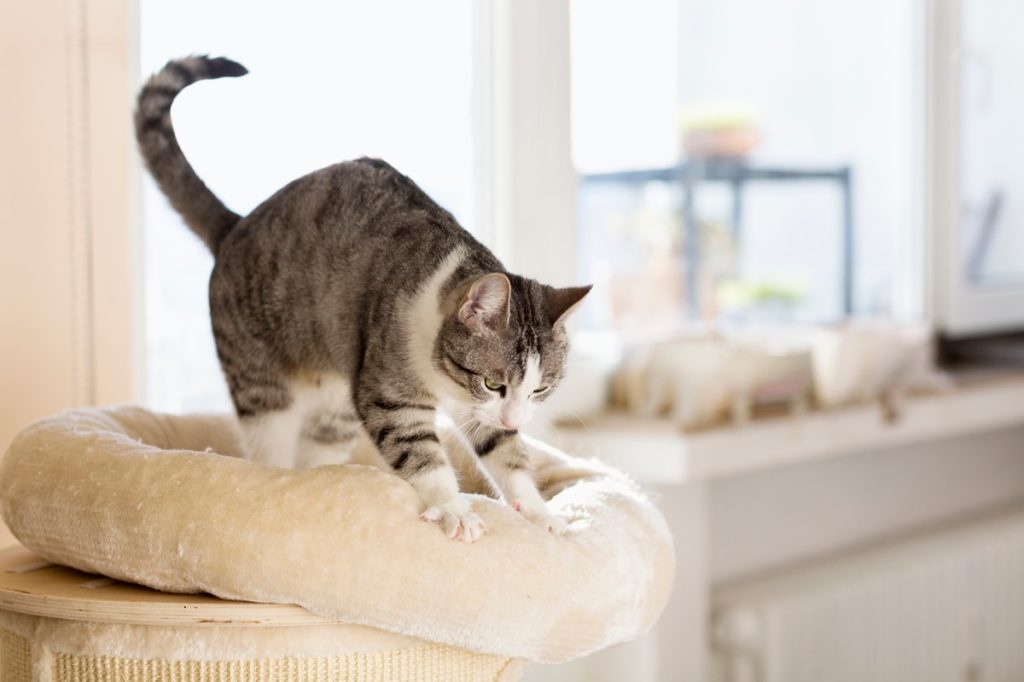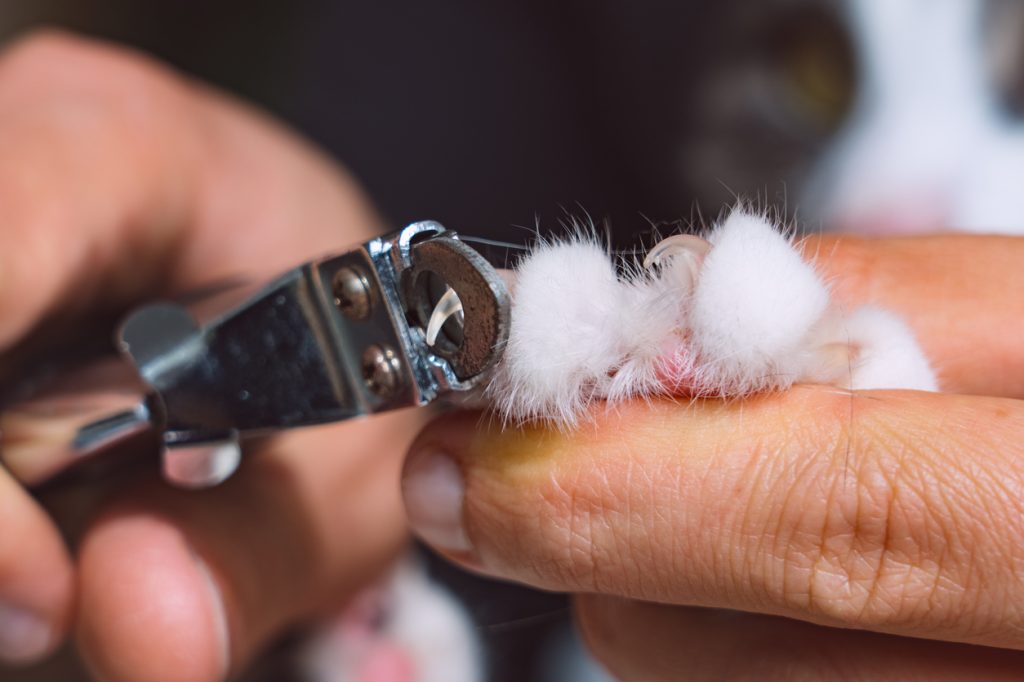How to Trim Cat Nails: A Step-by-Step Guide

Compared to other pets, cats are relatively low maintenance when it comes to their grooming needs. But while they can clean their own coats, their claws can become a problem if left unattended. Besides taking steps to pet-proof your home, knowing how to cut cat claws can help avoid serious damage to furniture and even have a positive impact on your pet’s overall health. We reached out to the experts to find out everything you need to know when you’re taking matters into your own paws. Read on for a step-by-step guide on how to trim cat nails, according to veterinarians and animal specialists.
RELATED: 6 Best Senior Cat Foods, According to Veterinarians.
Do You Have to Trim Your Cat’s Nails?

In many cases, felines don’t require the same level of attention as dogs when it comes to grooming requirements. But while many cats are able to bathe themselves, it’s a different story when it comes to getting their nails trimmed.
“It’s important to trim cat nails to prevent them from becoming overly long,” says Kathryn Dench, DVM, veterinary surgeon and chief scientific advisor to Paw Origins. “Regular trimming also helps prevent the nails from curling and growing into the pads, which can be very painful. In my clinical experience, approximately 40 percent of the cat consultations involve issues exacerbated by neglected claw care, emphasizing the importance of this practice.”
In addition to helping keep your cat healthy, trimming your cat’s claws can also reduce the likelihood of other problems—especially if they’re mostly indoor animals.
“Overgrown nails can increase the risk of scratches to humans or other animals in your home,” says Joey Lusvardi, certified cat behavior consultant at Class Act Cats. “It also increases the damage to your furniture: Even if they don’t scratch your furniture intentionally, your cat’s nails could get caught in the fabric as they walk across it.”
How Do You Know When It’s Time to Clip Your Cat’s Nails?

For the most part, cat nails remain hidden within their paws, which can make it difficult to tell when it’s time to trim them. That’s why experts say it’s usually best to pay attention to their footsteps around the house.
“The best time to trim your cat’s nails is when you can hear them clicking on hard surfaces or you can see that the nails are visibly protruding when your cat is relaxed,” says Dench. “Cats often retract their claws, so observing them while they are stretching or after they wake up can give you a good indication of their nail length.”
However, there are still some visual cues that it’s time for a nail trimming. “If the nails appear long and curved, are more brittle in nature, and especially if they start to curl back towards the paw pads, it is time for a trim,” says Nita Vasudevan, DVM, veterinary consultant for Embrace Pet Insurance.
You should also give special consideration to senior felines: Dench recommends that owners check the paws of older cats over 8 years old every week to catch any overgrown claws early.
“As cats get older, the old layers of nail do not fall off as easily, which can quickly lead to overlong, thickened claws which can grow into their pads,” she explains.
RELATED: 9 Pets That Are Great for Small Spaces.
How to Trim Cat Nails Safely

Knowing how to clip cat nails the right way involves a little more careful preparation than simply grabbing a pair of clippers and hoping for the best. Follow these steps, which should help you understand the ins and outs of caring for cat claws:
Make Them Comfortable
Nail trims can be difficult if your pet is particularly anxious or uncomfortable with having their paws touched. That’s why Lusvardi says the key to safely trimming cat nails is to ensure they are familiar with the process.
“Prepare your cat ahead of time by making the experience very positive,” he suggests. “It’s better to get them used to their paws being handled first rather than just diving in. It’s actually less work in the long run to help your cat acclimate to having their claws clipped rather than fighting them every time the clippers come out.”
For a fun way to chill out your cat, train them to give you a high five. “It helps get the cat used to touching your hand willingly so they learn it’s not scary. This can indirectly help with nail trims as you holding their paw won’t be as scary,” says Lusvardi.
Use the Right Clippers
Considering using human nail clippers to cut your cat’s claws? You might want to think again: Dench says it’s essential to use a “specially-designed cat nail clipper” for the delicate process.
They should also be sharp. “Dull clippers are more likely to splinter the nail and cause pain,” warns Lusvardi.
Expose the Nail and Clip
The next step is to gently press the paw pad to extend the nail.
“Trim only the white, sharp tip of the nail to avoid cutting into the quick, which is the pink part where blood vessels and nerves reside,” cautions Dench.
Vasudevan also suggests having styptic powder on hand to stop any bleeding if you accidentally cut your cat’s nails too short.
RELATED: 8 Cats That Don’t Shed, According to Veterinarians.
Take Your Time
Don’t worry too much about getting the chore done quickly. It can be easier for both you and your feline to take a more leisurely approach to the task.
“You don’t have to trim all their nails at once,” Lusvardi. “If you can only do one paw at a time and need to trim the other nails over four days, there’s nothing wrong with that. Listen to your cat.”
Reinforce the Positives of the Experience
Lusvardi says that, above all, it’s essential to keep your cat happy throughout the task, right down to clipping the last nail.
“Make it fun,” he suggests. “Distract your cat with a tasty treat during the whole process so they’ll be preoccupied and the experience will be a positive one.”
This especially means not scruffing your cat when handling it. “We no longer recommend this as a gentle technique as it is actually pretty painful for the cat,” he explains. “Similarly, using tools that can cause fear or stress for your cat is not necessary if you work slowly to get your cat comfortable.”
How to Avoid Cutting Your Cat’s Nails Too Short

Dench says that to avoid cutting cat nails too short, focus on trimming just the sharp tip of the nail.
“For cats with darker nails where the quick is not visible, make small cuts and stop when you see a small dark circle in the center of the nail’s base,” she suggests. “This is the beginning of the quick—which contains blood vessels—and no further cutting should be done beyond this point.”
Since finding the quick in a cat’s nail can be challenging—especially in cats with darker nails—Dench recommends using a bright light to backlight the claws to help make them more visible.
“This method reduces the risk of accidentally cutting them too short, making the trimming experience less stressful for both the cat and the owner,” she says.
RELATED: Is Pet Insurance Worth It? Understand the Pros and Cons.
How to Cut a Dewclaw

It’s important to remember that more than just the base of the paws must be considered when you’re clipping.
“The dewclaw in cats is located on the inner side of the front paws and does not touch the ground, so it does not wear down as the other nails do,” says Dench.
She says that this special nail should be trimmed just like the other nails. This includes taking care not to cut into the quick.
“Regular checks are necessary as these claws can grow in a circle and embed into the paw pad if left untrimmed,” Dench warns.
Conclusion
Knowing how to trim cat nails is essential to a proper grooming regimen. Not only will it keep your cat healthy, but trimming your cat’s nails can also reduce damage to your furniture as well as scratching injuries to yourself and other pets and people in your home.
But before you get started, it’s essential to know how to clip cat nails correctly. This means being careful not to accidentally cut beyond the sharp tip into the quick, which contains blood vessels and nerves. For most cats, it’s best to take your time with nail trims and start with one paw before working through all their nails over the course of a few days. And ultimately, it’s OK to seek some outside help.
“Remember, if you’re unsure or uncomfortable trimming cat nails, consult with your veterinarian or a professional groomer for assistance,” Vasudevan suggests.